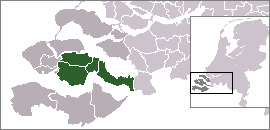Zuid-Beveland facts for kids
Zuid-Beveland is a peninsula in the province of Zeeland, located in the Netherlands. It used to be an island, but now it is connected to the mainland by bridges and dams. In 2016, about 95,000 people lived there. The area covers about 344 square kilometers (133 square miles).
Zuid-Beveland is home to four different municipalities: Borsele, Goes, Kapelle, and Reimerswaal. These municipalities are like local governments that manage the towns and villages within their areas.
Contents
Geography of Zuid-Beveland
Zuid-Beveland is in the southwestern part of the Netherlands. It is surrounded by water on several sides. To the north, you'll find the Oosterschelde estuary, which is a large arm of the sea. The Westerschelde estuary is to the south. These waters are important for shipping and nature.
How Zuid-Beveland Became a Peninsula
For a long time, Zuid-Beveland was a true island. But over the years, people built special structures to connect it to the mainland. These include dikes, dams, and bridges. This made it easier for people and goods to travel to and from the area. It also helped protect the land from floods.
The construction of the Delta Works was a big project that changed the geography of Zeeland. These works included many dams and barriers designed to protect the low-lying land from the sea. Because of these projects, Zuid-Beveland is now firmly connected to the rest of the Netherlands.
Life and Economy
Life in Zuid-Beveland is a mix of farming, industry, and tourism. The land is very fertile, which means it's great for growing crops.
Agriculture and Farming
Farming is a very important part of the economy here. Farmers grow many different kinds of crops, including potatoes, sugar beets, and various types of vegetables. Fruit farming, especially apples and pears, is also common. The mild climate and rich soil help these crops grow well.
Industry and Trade
Besides farming, there are also industries in Zuid-Beveland. Some towns have factories that process agricultural products. The port of Vlissingen, though not directly on Zuid-Beveland, is nearby and plays a role in trade for the region.
Tourism and Recreation
Many people visit Zuid-Beveland for its beautiful landscapes and quiet towns. Tourists enjoy cycling along the dikes, visiting historic villages, and exploring the nature reserves. The nearby beaches and water sports opportunities also attract visitors, especially during the summer months.
Important Towns
Zuid-Beveland has several notable towns, each with its own character.
Goes
Goes is the largest town on Zuid-Beveland and is often considered its main center. It has a historic town center with old buildings, shops, and restaurants. Goes is a hub for shopping and services for the surrounding area. It also has a marina, which is a place where boats are kept.
Kapelle
Kapelle is a smaller municipality known for its agricultural roots. It's surrounded by orchards and farmland. The town has a charming, rural feel and is a good example of a typical Zeeland village.
Borsele
The municipality of Borsele is known for its mix of agriculture and industry. It also has some beautiful nature areas along the Westerschelde. Borsele is home to some important industrial sites, but also many small, picturesque villages.
Reimerswaal
Reimerswaal is the easternmost municipality of Zuid-Beveland. It includes several villages and is also heavily involved in agriculture. The area has a rich history, with some parts of it having been lost to the sea in the past.
History of the Region
The history of Zuid-Beveland is closely tied to the sea and the constant struggle against floods.
Early Settlements
People have lived in Zuid-Beveland for many centuries. Early settlements were often built on higher grounds or artificial mounds called "terps" to protect them from high tides. Over time, people started building dikes to reclaim land from the sea and protect their homes and farms.
The Battle Against the Sea
Throughout history, Zuid-Beveland has faced many floods. One of the most famous was the North Sea flood of 1953. This terrible flood caused a lot of damage and loss of life across Zeeland. After this event, the Netherlands started the massive Delta Works project. This project built huge dams and barriers to protect the country from future floods, which also connected Zuid-Beveland more securely to the mainland.
Modern Development
Today, Zuid-Beveland is a thriving part of Zeeland. It balances its rich history and natural beauty with modern developments. The region continues to adapt to changes, always keeping its connection to the water and its agricultural heritage.
See also
 In Spanish: Zuid-Beveland para niños
In Spanish: Zuid-Beveland para niños


